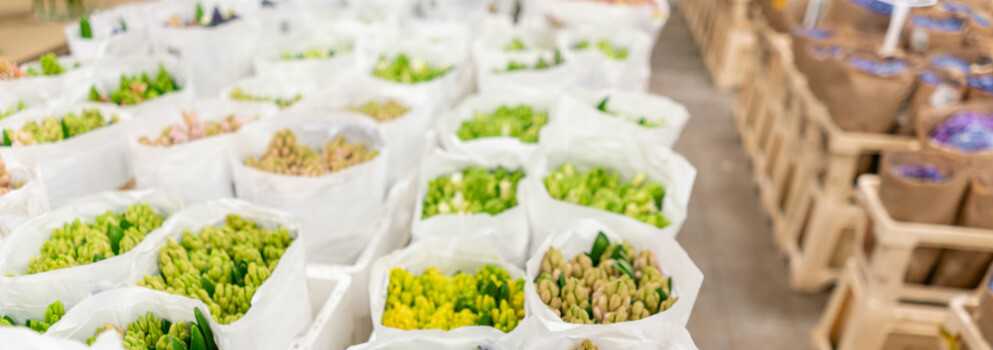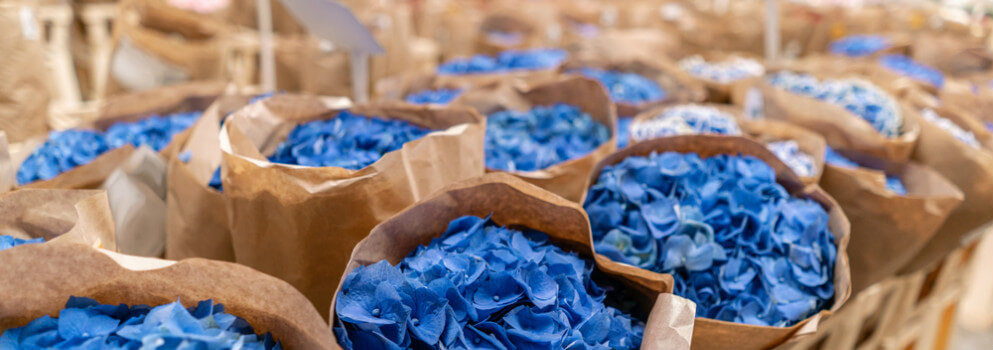
What Temperature Should Flowers Be Stored at for Best Preservation?
The demand for freshly cut flowers has made the development of improved methods of preservation necessary. Among various dynamics to consider when storing flowers, temperature regulation is a particularly critical factor.
Heat can adversely affect the longevity of cut plants by triggering premature aging and encouraging plant rot. Also, elevated temperatures will increase the rate at which plant respiration occurs leading to ethylene gas generation and further heat generation. The overall effect of these events is a faster onset of aging for storage flowers.

How to Preserve Cut Flowers for Wholesale
Learning how florists keep flowers fresh is critical for the success of flower-growers and wholesalers. The various factors to consider in the post-harvest care of cut flowers are outlined below.
Carbohydrate Retention
The carbohydrate stores in most cut flowers will be rapidly depleted following harvest. If preventive measures are not taken to quickly slow this process, the plants will wilt and die.
An effective way of retaining glucose and other carbohydrates within flower stems is by the process of “pulsing.” Pulsing is done by immersing the roots of cut flowers in special solutions which are typically sugar-based. Plant roots suspended within these solutions for a few hours will absorb sufficient amounts of carbohydrates to maintain their stores.
Other solutions which can be employed in pulsing flowering plants include:
- Silver thiosulfate (particularly useful in pulsing ethylene-sensitive plants)
- Gibberellic acid (prevents leaf yellowing)
- Silver nitrate
Ethylene Inhibition
Another vital strategy employed to keep flowers fresh is the elimination of ethylene generated both by plant respiration as well as gas derived from exogenous sources. Ethylene gas is harmful to most flower species and leads to petal abscission (shattering) and wilting.
Some rose species, carnations and delphiniums are particularly sensitive to even low concentrations of ethylene gas and require special preservation techniques.
Ethylene can be produced by various processes including plant respiration, the ripening of fruits and burning of organic materials. This unwanted gas can be eliminated using various inhibitors including:
- Pulsing with silver thiosulfate complexes
- Treatment with gas-based ethylene inhibitors
- Refrigeration of cut flowers in floral chillers or cold rooms
If correctly used, these techniques will effectively remove ethylene gas and improve the duration of storage for flowers.
Temperature
Like all other living organisms, flowering plants undergo respiratory processes that generate heat. Retention of this heat of metabolism has been linked to the rapid aging of cut flowers.
Although ambient heat is easily eliminated in most open-air locations, storing cut flowers in sealed boxes hastens the rate at which they age. This decrease in longevity is due to the undissipated thermal energy retained around the flowers. As a result, the flowers will respire at a faster rate, generate more heat and hence age quicker.
To avoid storing flowers in a hot and harmful environment, wholesale florists should consider cooling systems for flower storage. Floral chillers can help keep the ambient temperatures in floral preservation units within acceptable ranges thus ensuring flowers remain fresh for longer.
Hydration and Humidity
To ensure flowers last longer, high levels of humidity are required. Ambient air saturation should be around 90% – 95%. Also, cut flowers will require adequate rehydration once they’ve been harvested from their source plants.
To achieve optimal hydration levels, flower stems should be immersed in clean water free of contaminants which may impair the free flow of water through them. When properly hydrated, flowers will retain their freshness for longer periods.
It is vital to recognize that the presence of air bubbles or bacteria in cut plant stems may stagnate water transport through their lumen and this problem should be addressed in the post-harvest care of flowers.

Best Flower Storage Temperature
Deciding the best temperature to store flowers depends on the species intended for preservation. For most flower types, optimal storage temperatures range between 33°F – 37°F while cold-sensitive blossoms and tropical flowers should be maintained at temperatures above 50°F.
Atmospheric Temperature
Ideally, the optimal atmospheric temperature for flowers should be closely regulated. Thermal conditions within the storage facility should be monitored to closely mirror the temperature within the cut flower boxes. In most instances, temperatures should not exceed 40°F.
Water Temperature
Once fresh flowers have been cut, they are immersed in water to prevent dehydration. For most wholesale florists in the flower industry, the use of lukewarm water is ideal. With a few exceptions, hydration with warm water is preferable as its molecules are more easily absorbed by flower stems than cold water. In most cases the best water temperature for flowers is between 100°F – 110°F.
Ideal Storage Temperatures by Flower Type
| Flower Type | Ideal Storage Temp (°F) | Notes |
|---|---|---|
| Roses | 34 – 36 | Keep humidity at 90 – 95% |
| Tulips | 33 – 35 | Store dry to prevent stem elongation |
| Orchids | 50 – 55 | Tropical; avoid cold damage |
| Carnations | 33 – 36 | Very sensitive to ethylene |
| Lilies | 34 – 36 | Keep upright to prevent stem bending |
How to Maintain the Temperature for Cut Flowers
Attaining the right temperature control for flowers can be satisfactorily done with the use of chiller systems and water-cooling systems. These devices can be used to regulate the temperatures at which cut florets are stored and transported ensuring longer shelf lives.
Check Out Cold Shot Chillers’ Selection of Flower Chillers
For decades, Cold Shot Chillers has continued to deliver top quality industrial water chillers and cooling solutions to clients. We remain committed to producing high-quality air-cooled chillers that are suited to various processes including applications in the floral industry. So feel free to explore our related products such as hydroponic water chillers, portable air cooled chillers, and a wide range of chiller parts to support your floral preservation and cooling needs.
Please contact us today for more information about our process cooling services or to request a quote.